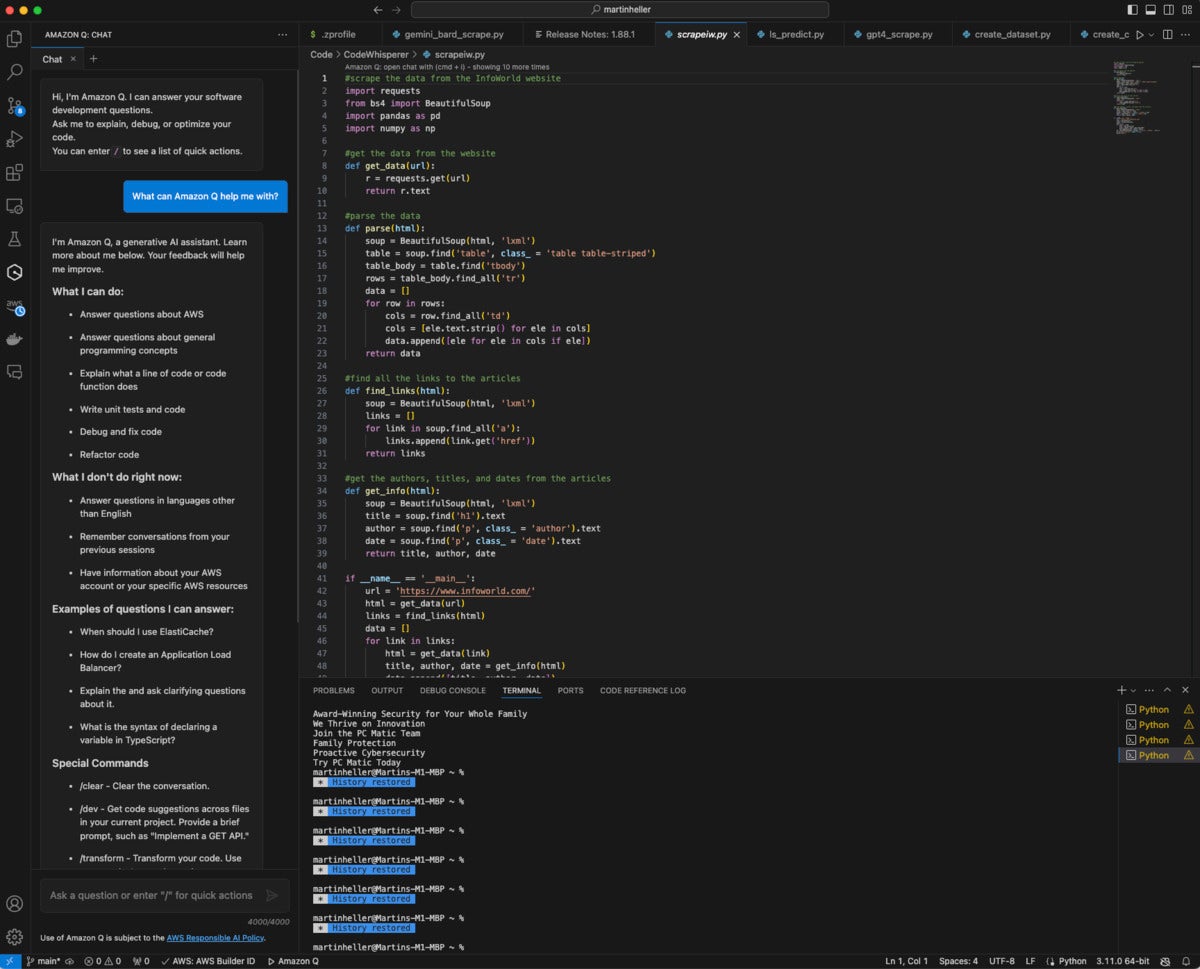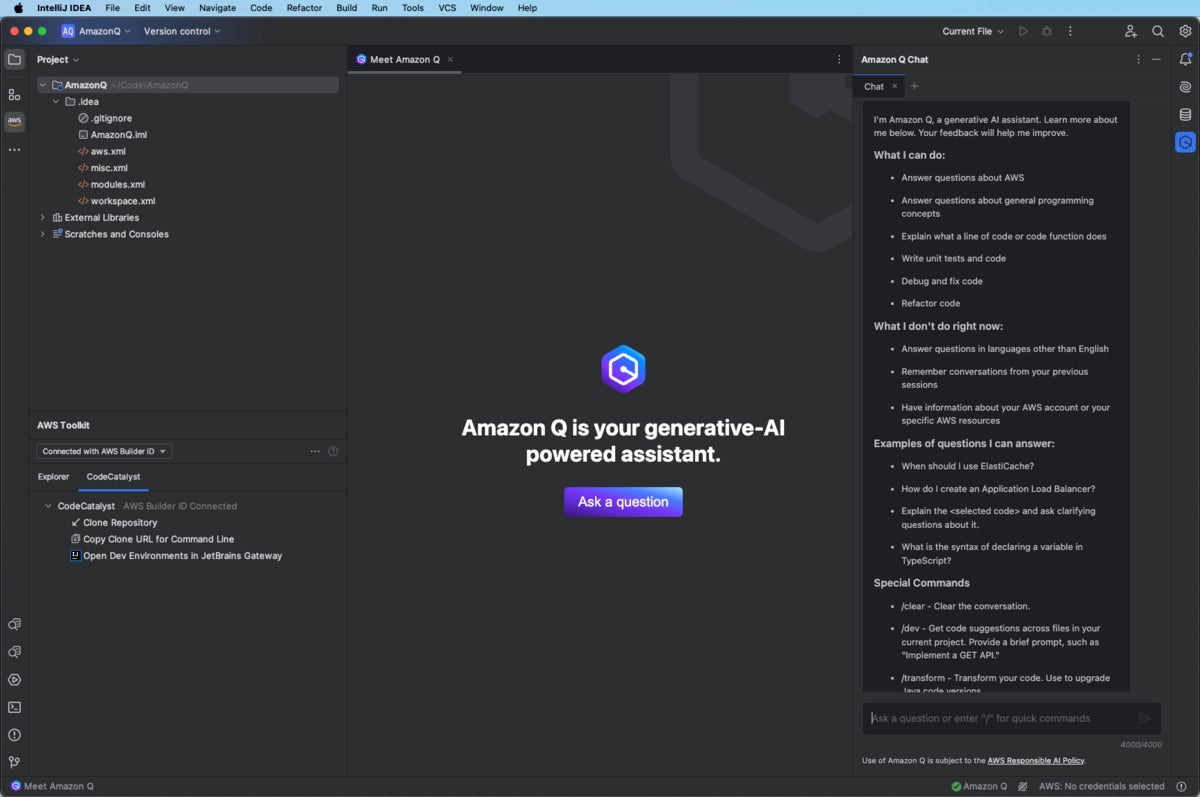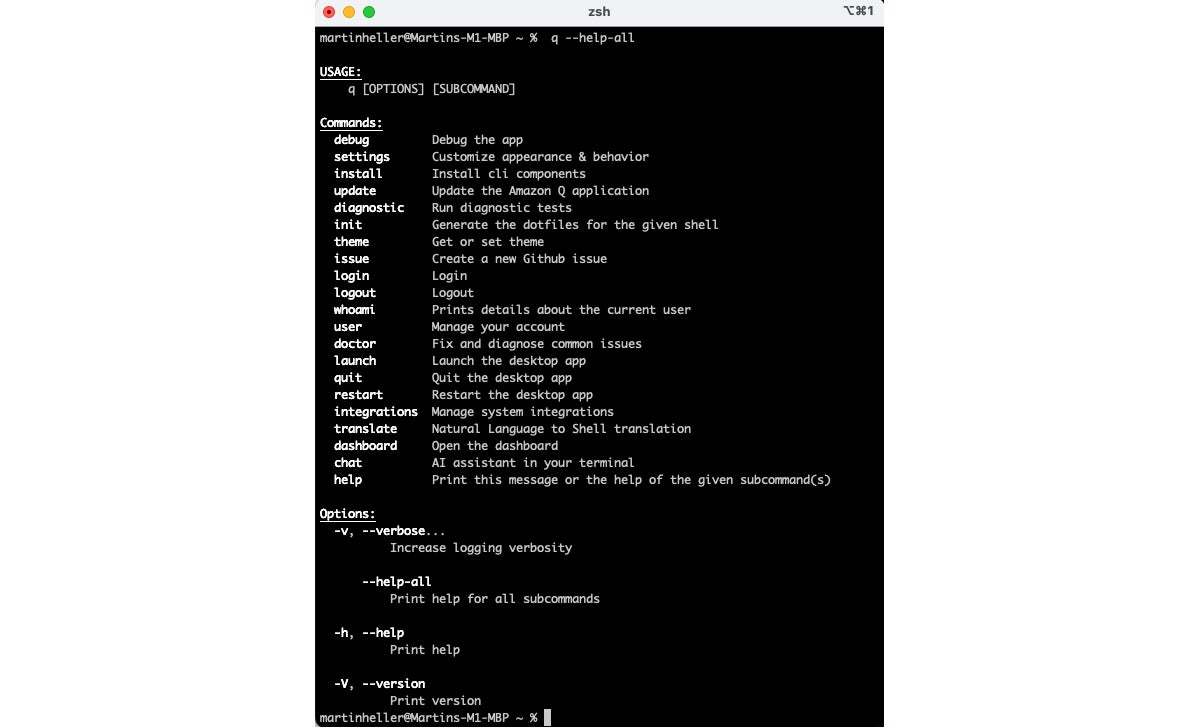
When I reviewed Amazon CodeWhisperer, Google Bard, and GitHub Copilot in June of 2023, CodeWhisperer could generate code in an IDE and did security reviews, but it lacked a chat window and code explanations. The current version of CodeWhisperer is now called Amazon Q Developer, and it does have a chat window that can explain code, and several other features that may be relevant to you, especially if you do a lot of development using AWS.
Amazon Q Developer currently runs in Visual Studio Code, Visual Studio, JetBrains IDEs, the Amazon Console, and the macOS command line. Q Developer also offers asynchronous agents, programming language translations, and Java code transformations/upgrades. In addition to generating, completing, and discussing code, Q Developer can write unit tests, optimize code, scan for vulnerabilities, and suggest remediations. It supports conversations in English, and code in the Python, Java, JavaScript, TypeScript, C#, Go, Rust, PHP, Ruby, Kotlin, C, C++, shell scripting, SQL, and Scala programming languages.
You can chat with Amazon Q Developer about AWS capabilities, and ask it to review your resources, analyze your bill, or architect solutions. It knows about AWS well-architected patterns, documentation, and solution implementation.
According to Amazon, Amazon Q Developer is “powered by Amazon Bedrock” and trained on “high-quality AWS content.” Since Bedrock supports many foundation models, it’s not clear from the web statement which one was used for Amazon Q Developer. I asked, and got this answer from an AWS spokesperson: “Amazon Q uses multiple models to execute its tasks and uses logic to route tasks to the model that is the best fit for the job.”
Amazon Q Developer has a reference tracker that detects whether a code suggestion might be similar to publicly available code. The reference tracker can label these with a repository URL and project license information, or optionally filter them out.
Amazon Q Developer directly competes with GitHub Copilot, JetBrains AI, and Tabnine, and indirectly competes with a number of large language models (LLMs) and small language models (SLMs) that know about code, such as Code Llama, StarCoder, Bard, OpenAI Codex, and Mistral Codestral. GitHub Copilot can converse in dozens of natural languages, as opposed to Amazon Q Developer’s one, and supports a number of extensions from programming, cloud, and database vendors, as opposed to Amazon Q Developer’s AWS-only ties.
Installing Amazon Q Developer
Given the multiple environments in which Amazon Q Developer can run, it’s not a surprise that there are multiple installers. The only tricky bit is signing and authentication.
Installing Q Developer in Visual Studio Code
You can install Amazon Q Developer from the Visual Studio Code Marketplace, or from the Extensions sidebar in Visual Studio Code. You can get to that sidebar from the Extensions icon at the far left, by pressing Shift-Command-X, or by choosing Extensions: Install Extensions from the command palette. Type “Amazon Q” to find it. Once you’ve installed the extension, you’ll need to authenticate to AWS as discussed below.
 IDG
IDG
Amazon Q Developer in Visual Studio Code includes a chat window (at the left) as well as code generation. The chat window is showing Amazon Q Developer’s capabilities.
Installing Q Developer in JetBrains IDEs
Like Visual Studio Code, JetBrains has a marketplace for IDE plugins, where Amazon Q Developer is available. You’ll need to reboot the IDE after downloading and installing the plugin. Then you’ll need to authenticate to AWS as discussed below. Note that the Amazon Q Developer plugin disables local inline JetBrains full-line code completion.
 IDG
IDG
Amazon Q Developer in IntelliJ IDEA, and other JetBrains IDEs, has a chat window on the right as well as code completion. The chat window is showing Amazon Q Developer’s capabilities.
Installing Q Developer in the AWS Toolkit for Visual Studio
For Visual Studio, Amazon Q Developer is part of the AWS Toolkit, which you can find it in the Visual Studio Marketplace. Again, once you’ve installed the toolkit you’ll need to authenticate to AWS as discussed below.
Signing and authenticating Amazon Q Developer
The authentication process is confusing because there are several options and several steps that bounce between your IDE and web browser. You used to have to repeat this process frequently, but the product manager assures me that re-authentication should now only be necessary every three months.
Installing Q Developer for command line
Amazon Q Developer for the command line is currently for macOS only, although a Linux version is on the roadmap and documented as a remote target. The macOS installation is basically a download of a DMG file, followed by running the disk image, dragging the Q file to the applications directory, and running that Q app to install the CLI q program and a menu bar icon that can bring up settings and the web user guide. You’ll also need to authenticate to AWS, which will log you in.
 IDG
IDG
On macOS, the command-line program q supports multiple shell programs and multiple terminal programs. Here I’m using iTerm2 and the z shell. The q translate command constructs shell commands for you, and the q chat command opens an AI assistant.
Amazon Q Developer in the AWS Console
If you are running as an IAM user rather than a root user, you’ll have to add IAM permissions to use Amazon Q Developer. Once you have permission, AWS should display an icon at the right of the screen that brings up the Amazon Q Developer interface.
 IDG
IDG
The Amazon Q Developer window at the right, running in the AWS Console, can chat with you about using AWS and can generate architectures and code for AWS applications.
Evaluating Amazon Q Developer
According to AWS, “Amazon Q Developer Agent achieved the highest scores of 13.4% on the SWE-Bench Leaderboard and 20.5% on the SWE-Bench Leaderboard (Lite), a data set that benchmarks coding capabilities. Amazon Q security scanning capabilities outperform all publicly benchmarkable tools on detection across the most popular programming languages.”
Both of the quoted numbers are reflected on the SWE-Bench site, but there are two issues. Neither number has as yet been verified by SWE-Bench, and the Amazon Q Developer ranking on the Lite Leaderboard has dropped to #3. In addition, if there’s a supporting document on the web for Amazon’s security scanning claim, it has evaded my searches.
SWE-Bench, from Cornell, is “an evaluation framework consisting of 2,294 software engineering problems drawn from real GitHub issues and corresponding pull requests across 12 popular Python repositories.” The scores reflect the solution rates. The Lite data set is a subset of 300 GitHub issues.
Let’s explore how Amazon Q Developer behaves on the various tasks it supports in some of the 15 programming languages it supports. This is not a formal benchmark, but rather an attempt to get a feel for how well it works. Bear in mind that Amazon Q Developer is context sensitive and tries to use the persona that it thinks best fits the environment where you ask it for help.
Predictive inline code generation with Amazon Q Developer
I tried a softball question for predictive code generation and used one of Amazon’s inline suggestion examples. The Python prompt supplied was # Function to upload a file to an S3 bucket. Pressing Option-C as instructed got me the code below the prompt in the screenshot below, after an illegal character that I had to delete. I had to type import at the top to prompt Amazon Q to generate the imports for logging, boto3, and ClientError.
I also used Q Chat to tell me how to resolve the imports; it suggested a pip command, but on my system that fixed the wrong Python environment (v 3.11). I had to do a little sleuthing in the Frameworks directory tree to remind myself to use pip3 to target my current Python v 3.12 environment. I felt like singing “Daisy, Daisy” to Dave and complaining that my mind was going.
 IDG
IDG
Inline code generation and chat with Amazon Q Developer. All the code below the # TODO comment was generated by Amazon Q Developer, although it took multiple steps.
I also tried Amazon’s two other built-in inline suggestion examples. The example to complete an array of fake users in Python mostly worked; I had to add the closing ] myself. The example to generate unit tests failed when I pressed Option-C: It generated illegal characters instead of function calls. (I’m starting to suspect an issue with Option-C in VS Code on macOS. It may or may not have anything to do with Amazon Q Developer.)
When I restarted VS Code, tried again, and this time pressed Return on the line below the comment, it worked fine, generating the test_sum function below.
# Write a test case for the above function. def test_sum(): “”” Unit test for the sum function. “”” assert sum(1, 2) == 3 assert sum(-1, 2) == 1 assert sum(0, 0) == 0
AWS shows examples of completion with Amazon Q Developer in up to half a dozen programming languages in its documentation. The examples, like the Python ones we’ve discussed, are either very simple, e.g. add two numbers, or relate to common AWS operations supported by APIs, such as uploading files to an S3 bucket.
Natural language to code generation with Amazon Q Developer
Since I now believed that Amazon Q Developer can generate Python, especially for its own test examples, I tried something a little different. As shown in the screenshot below, I created a file called quicksort.cpp, then typed an initial comment:
//function to sort a vector of generics in memory using the quicksort algorithm
Amazon Q Developer kept trying to autocomplete this comment, and in some cases the implementation as well, for different problems. Nevertheless it was easy to keep typing my specification while Amazon Q Developer erased what it had generated, and Amazon Q Developer eventually generated a nearly correct implementation.
Quicksort is a well-known algorithm. Both the C and C++ libraries have implementations of it, but they don’t use generics. Instead, you need to write type-specific comparison functions to pass to qsort. That’s historic, as the libraries were implemented before generics were added to the languages.
